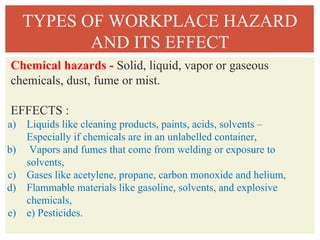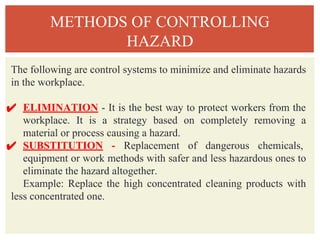TLE 8 - TECHNICAL DRAFTING (HAZARD AND RISK)
- 2. QUARTER 3 ¨C WEEK 7-8 HAZARD AND RISK
- 3. OCCUPATIONAL SAFETY AND HEALTH Occupational Safety and Health is a cross-disciplinary area concerned with protecting the safety, health and welfare of people engaged in work or employment. As a secondary effect, it may also protect co-workers, family members, employers, customers, suppliers nearby communities, and other members of the public who are affected by the workplace environment.
- 4. OCCUPATIONAL HEALTH RECORD The occupational health record includes information health status documented on an employee, including personal and occupational health histories as well the opinions and written evaluations generated in the course diagnosis, employment-related treatment, and examination by healthcare professionals and technicians.
- 5. HAZARD is a term used to describe something that has the potential to cause harm.
- 6. RISK is a measure of the possibility of a specific harmful effect in given circumstances. It is very important to know the difference between a hazard and a risk.
- 7. TYPES OF WORKPLACE HAZARD AND ITS EFFECT Biological hazards - Caused by organisms such as viruses, bacteria, fungi and parasites. EFFECTS : a) Blood and other body fluids, b) Fungi/mold, c) Bacteria and viruses, d) Plants, e) Insect bites, f) Animal and bird droppings
- 8. TYPES OF WORKPLACE HAZARD AND ITS EFFECT Chemical hazards - Solid, liquid, vapor or gaseous chemicals, dust, fume or mist. EFFECTS : a) Liquids like cleaning products, paints, acids, solvents ¨C Especially if chemicals are in an unlabelled container, b) Vapors and fumes that come from welding or exposure to solvents, c) Gases like acetylene, propane, carbon monoxide and helium, d) Flammable materials like gasoline, solvents, and explosive chemicals, e) e) Pesticides.
- 9. TYPES OF WORKPLACE HAZARD AND ITS EFFECT Ergonomic hazards - Anatomical, physiological, and psychological demands on the worker, such as repetitive and forceful movements, vibration, extreme temperatures, and awkward postures arising from improper work methods and improperly designed workstations, tools, and equipment.
- 10. EFFECTS : a) Improperly adjusted workstations and chairs, b) Frequent lifting, c) Poor posture, d) Awkward movements, especially if they are repetitive, e) Having to use too much force, especially if you have to do it frequently, f) Vibration.
- 11. TYPES OF WORKPLACE HAZARD Physical hazards - Noise, vibration, energy, weather, electricity, radiation and pressure. EFFECTS : a) Radiation: including ionizing, nonionizing (EMF¡¯s, microwaves, radio waves, etc.), b) Over exposure to sunlight/ultraviolet rays, c) Temperature extremes ¨C hot and cold, d) Constant loud noise.
- 12. TYPES OF WORKPLACE HAZARD Psychological hazards - Those that are basically causing stress to a worker. This kind of hazard troubles an individual very much to an extent that his general well-being is affected. EFFECTS : a) Bullying, b) Extremely long working hours causing undue stress worker, c) conflict within co-workers, d) isolated work, e) low recognition and rewards.
- 13. METHODS OF CONTROLLING HAZARD The following are control systems to minimize and eliminate hazards in the workplace. ? ELIMINATION - It is the best way to protect workers from the workplace. It is a strategy based on completely removing a material or process causing a hazard. ? SUBSTITUTION - Replacement of dangerous chemicals, equipment or work methods with safer and less hazardous ones to eliminate the hazard altogether. Example: Replace the high concentrated cleaning products with less concentrated one.
- 14. METHODS OF CONTROLLING HAZARD ? ENGINEERING CONTROLS - These are strategies designed to protect workers from hazardous conditions by placing a barrier between the worker and the hazard or by removing a hazardous substance through air ventilation. This involves a physical change to the workplace itself, rather than relying on workers' behavior or requiring workers to wear protective clothing. ? WORK PRACTICE AND/OR ADMINISTRATIVE CONTROLS - Work practice controls change the way workers do their jobs to reduce exposure to hazards. Administrative controls address how the work is structured, such as work pace and breaks. Example: Rotating workers to reduce the amount of time they are exposed to the hazard and providing training.
- 15. METHODS OF CONTROLLING HAZARD ? PERSONAL PROTECTIVE EQUIPMENT (PPE) - PPE is the least effective way to protect workers from workplace hazards. It is an equipment worn to minimize exposure to hazards that cause serious workplace injuries and illnesses. These injuries and illnesses may result from contact with chemical, radiological, physical, electrical, mechanical, or other workplace hazards. Personal protective equipment may include the following: Gloves, Face Masks, Face Shield, Goggles and Safety Shoes.
- 18. Take a picture of you while performing EMERGENCY DRILL or Responding to Emergency Related-Drill RUBRICS : ACCURACY - 10 PTS COMPLETENESS - 10 PTS Directions: Identify Hazards at Work 1. Draw a drawing workplace, it must show work areas, equipment, tools etc. 2. When finished, you will decide where hazards are located in the workplace and mark them. Use the ff. codes: RED- safety hazards and physical hazards BLUE- biological hazards and chemical hazards GREEN- ergonomic and psychological hazards ACCURACY : 10 PTS COMPLETION : 5 PTS NEATNESS AND CREATIVITY - 5 PTS

















